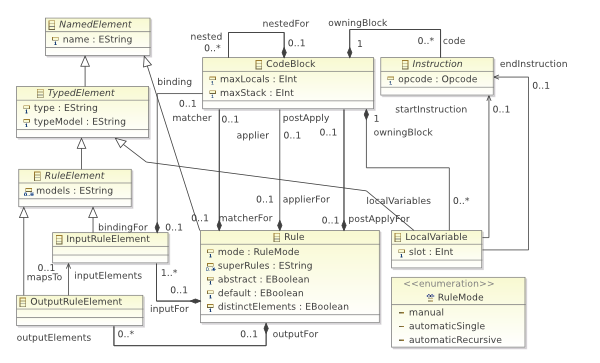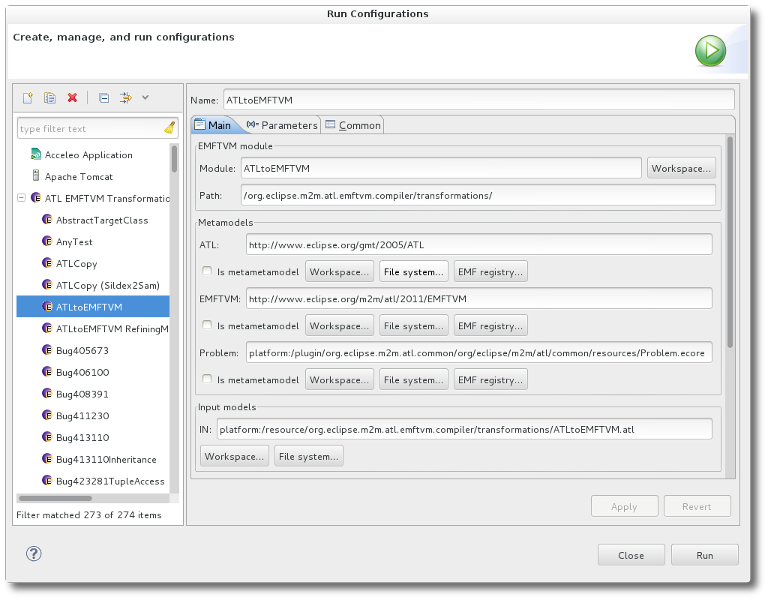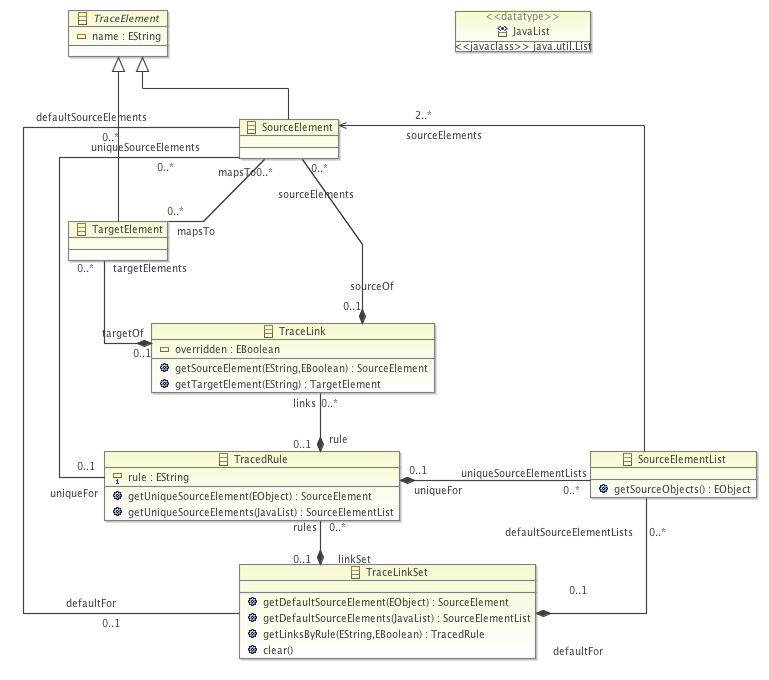Notice: this Wiki will be going read only early in 2024 and edits will no longer be possible. Please see: https://gitlab.eclipse.org/eclipsefdn/helpdesk/-/wikis/Wiki-shutdown-plan for the plan.
Difference between revisions of "ATL/EMFTVM"
m |
m |
||
| Line 170: | Line 170: | ||
Apart from navigating the trace model yourself, you can use one of these built-in helper operations as well: | Apart from navigating the trace model yourself, you can use one of these built-in helper operations as well: | ||
| − | '''helper def''' : resolveTemp(var : OclAny, target_pattern_name : String) | + | '''helper def''' : resolveTemp(var : OclAny, target_pattern_name : String) : OclAny |
| − | '''helper def''' : resolveTemp(var : OclAny, rule_name : String, target_pattern_name : String) | + | '''helper def''' : resolveTemp(var : OclAny, rule_name : String, target_pattern_name : String) : OclAny |
| − | '''helper context''' OclAny '''def''' : resolve() | + | '''helper context''' OclAny '''def''' : resolve() : OclAny |
| − | '''helper context''' OclAny '''def''' : resolve(rule : String) | + | '''helper context''' OclAny '''def''' : resolve(rule : String) : OclAny |
| + | '''helper context''' Collection(OclAny) '''def''' : resolve() : Sequence(OclAny) | ||
| + | '''helper context''' Collection(OclAny) '''def''' : resolve(rule : String) : Sequence(OclAny) | ||
The first "resolveTemp" operation is well-known, and resolves a named target element for a given source element, using the default traces. The second "resolveTemp" resolves a "unique" trace, and also requires the name of the rule for which the requested trace is unique. | The first "resolveTemp" operation is well-known, and resolves a named target element for a given source element, using the default traces. The second "resolveTemp" resolves a "unique" trace, and also requires the name of the rule for which the requested trace is unique. | ||
The first "resolve" operation implements the implicit tracing mechanism: it is invoked on a source element, and returns its default target element, if any. If there is no default target element, it just returns the source element. The second "resolve" operation also takes a rule name as parameter, and uses the unique traces for that rule to resolve a target element. If there is no unique target element for that rule and source element, it returns the source element. | The first "resolve" operation implements the implicit tracing mechanism: it is invoked on a source element, and returns its default target element, if any. If there is no default target element, it just returns the source element. The second "resolve" operation also takes a rule name as parameter, and uses the unique traces for that rule to resolve a target element. If there is no unique target element for that rule and source element, it returns the source element. | ||
| + | |||
| + | The last two "resolve" operations are defined on Collections, and resolve each element in the collection to a target element. The elements are returned in a Sequence: the order in which the input Collection returns the source elements is maintained in the output. | ||
| + | |||
| + | Fun fact: | ||
| + | |||
| + | target_property <- s.source_property | ||
| + | |||
| + | is equivalent to | ||
| + | |||
| + | target_property <:= s.source_property.resolve() | ||
== Publications == | == Publications == | ||
Revision as of 13:03, 17 February 2012
Contents
ATL EMF Transformation Virtual Machine (research VM)
Since 2011, the ATL tools include a research VM (EMFTVM), which allows for experimentation with advanced language features. Currently, these features include:
- New bytecode format with explicit representation of rules [1]
- Compiler defined as higher-order ATL transformation [2]
- Multiple rule inheritance
- Module import that works with rule inheritance
- Closures
- Multiple dispatch for helper methods
- Lazy implementation of OCL collections
- Advanced tracing
Architecture
The EMF Transformation Virtual Machine (EMFTVM) is derived from the current ATL VMs and bytecode format. However, instead of using a proprietary XML format, it stores its bytecode as EMF models, such that they may be manipulated by model transformations. A special EMF resource implementation allows EMFTVM models to be stored in binary format, which is faster to load and save, and results in smaller files.
Apart from the standard ATL bytecode primitives, such as modules, fields, and operations, EMFTVM bytecode includes rules and code blocks. Fig. 1 shows the structure of rules and code blocks. Code blocks are executable lists of instructions, and have a number of local variables and a local stack space. Operation bodies and field initialisers are represented as code blocks in EMFTVM. Code blocks may also have nested code blocks, which can be manipulated and invoked from its containing block. These nested code blocks therefore effectively represent closures, which are nameless functions that can be passed as parameters to other functions. Closures are helpful for the implementation of OCL's higher-order operations, such as select and collect, which are parametrised by nested OCL expressions.

Fig. 1: Structure of EMFTVM rules and code blocks
Rules consist of input and output rule elements, a matcher code block, applier code block, and post-apply code block. The matcher code block takes potential input element candidates as parameters, and returns a boolean value, representing a match. The applier code block takes the input and (newly created) output elements as parameters, and assigns the bindings of the output elements. The post-apply code block also takes the input and output elements as parameters, and performs any (imperative) post-processing specified in the rule. Execution of rules is therefore done in three phases: (1) matching; only input elements are guaranteed to be present, (2) applying; all output elements and traces are guaranteed to exist, but no bindings may have been applied, (3) post-apply; all input and output elements, traces, and bindings are guaranteed to be present.
Rules can be invoked manually, automatically, and recursively automatically. Manual rules correspond to ATL lazy rules (and called rules). Automatic rules correspond to ATL matched rules. Recursively automatic rules do not apply to ATL, but can be used when compiling other transformation languages to EMFTVM. Rules can also be marked as default, which causes that rule to create default traces. Default traces can be looked up using ATL's implicit tracing mechanism, and only one default trace may exist for any given source pattern. Non-default traces are just stored in the trace model, and are not used by the EMFTVM transformation engine.
Rules can have a number of super-rules, which are stored by name. This decision allows EMFTVM to resolve and link the super-rules of each rule at load-time, whereas storing a super-rule reference would have hardcoded the super-rule in the bytecode. This is comparable to how the Java VM does super-class lookup. Finally, rules can be marked as abstract, which means that they are only applied as part of a non-abstract sub-rule, but never by themselves.
To summarise: by explicitly representing rules in the bytecode, rule inheritance can be resolved at load-time. As a consequence, rules stored in imported modules can be taken into account, and super-rules can be redefined by module superimposition before the reference to the super-rule is resolved in the sub-rules. This solves the historic mismatch between ATL's rule inheritance and module superimposition.
How to use EMFTVM?
Installation
EMFTVM is currently only available from ATL CVS, but will be included in the next ATL release (3.3). As a temporary measure, EMFTVM can be downloaded as an ATL add-on for ATL 3.1 or up from [3]
Compiling to EMFTVM
To use EMFTVM for your ATL transformations, just add "-- @atlcompiler emftvm" on the first line of your ATL module to compile them to EMFTVM. An example ATL file can be found at [4].
Running EMFTVM modules
EMFTVM includes a separate launch configuration dialog that looks very much like ATL's launch configuration dialog (see Fig. 2). It can be found via "Run -> Run Configurations...".

Fig. 2: EMFTVM Launch Configuration Dialog
EMFTVM also includes its own Ant tasks. See [5] to find out how to use the Ant tasks.
Rule Inheritance
ATL rule inheritance is limited to single inheritance between rules within the same module. This limitation is hardwired in the ATL grammar, and cannot easily be changed. Therefore, the EMFTVM compiler introduces support for a rule inheritance @extends annotation, which supports multiple inheritance between rules situated in any module:
-- @extends SuperRule1, SuperRule2
rule SubRule {
....
}
To use this annotation, the regular ATL extends keyword must not be used: the regular ATL extends keyword will override the @extends annotation.
Multiple dispatch
EMFTVM support multiple dispatch of ATL helpers. This means you can greatly reduce the amount of "oclIsKindOf()" checks in your code, because you can simply write a new helper with the required context/parameter type (not only the context is virtual, but also all parameters). To illustrate how this works, look at the following ATL code:
-- These helpers check for value equality (as opposed to object identity equality). -- The base case checks meta-type equality, and covers -- comparison of different element types, including OclUndefined. helper context OclAny def : sameAs(other : OclAny) : Boolean = self.oclType() = other.oclType(); helper context OCL!"OclType" def : sameAs(other : OCL!"OclType") : Boolean = super.sameAs(other) and self.name = other.name; helper context OCL!CollectionType def : sameAs(other : OCL!CollectionType) : Boolean = super.sameAs(other) and self.elementType.sameAs(other.elementType);
In regular ATL, you cannot assume the parameter types to be correct: you must make sure you invoke the helpers with the correct parameter types. You certainly cannot expect ATL to invoke a different helper, based on the types of the parameters! In the case of the above code, regular ATL will invoke one of the three "sameAs" helpers based only on the context type (and the number of parameters). That means that it is pointless to change the type of the "other" parameter to "OCL!OclType" in the second "sameAs", because ATL will not use it.
EMFTVM does use the parameter types, however. EMFTVM will only invoke the second "sameAs" as soon as both the context and the "other" parameter are of type "OCL!OclType". Otherwise, it will invoke the first "sameAs". As a comparison, the second "sameAs" would have to look like this in regular ATL:
helper context OCL!"OclType" def : sameAs(other : OclAny) : Boolean = if other.oclIsKindOf(OCL!"OclType") then super.sameAs(other) and self.name = other.name else super.sameAs(other) endif;
Secondly, OclUndefined is an instance of OclAny in EMFTVM, which means that you can invoke helpers on it. That's why the first "sameAs" in our example works! To compare, this is what you would have to write in regular ATL:
helper context OclAny def : sameAs(other : OclAny) : Boolean = if other.oclIsUndefined() then false else self.oclType() = other.oclType() endif;
Lazy collections
EMFTVM provides a lazy implementation of the OCL collection types. That means you can invoke operations on the collections, but those operations will not be executed until you actually evaluate the collection. Also, collection operations will only be evaluated partially, depending on how much of the collection you evaluate. To illustrate how this works, look at the following example code:
query lazytest = (100).run()->collect(x | x.expensive())->last();
helper context Integer def : run() : Sequence(Integer) =
if self <= 0 then
Sequence{0}
else
(self - 1).run()->append(self)
endif;
helper context Integer def : expensive() : Integer =
(self * self).debug('expensive');
The above query will first invoke "run" on 100, which creates a Sequence of all numbers from 0 to 100. Then, the query invokes "collect" on that Sequence, and replaces each value in the Sequence by its squared value (the "expensive" operation). Finally, we're only interested in the last value of the changed Sequence.
In regular ATL, everything is evaluated left-to-right, and the whole {0..100} Sequence is converted to a Sequence of squared values before the last value is returned. In EMFTVM, "collect" returns a lazy Sequence, which is just waiting to be evaluated. Only when "last" is invoked on the lazy Sequence will the Sequence invoke the "expensive" operation on the last element of the input Sequence. As a result, "expensive" is only invoked once by EMFTVM.
Of course, the above example does not seem a very practical one. However, the following OCL patterns probably do ring a bell for you:
mySequence->select(x | x.oclIsKindOf(MM!MyType))->first()
MM!MyType.allInstances()->first()
In regular ATL, all elements are computed before invoking "first". In EMFTVM, only the first element of each sequence is evaluated. In fact, the "select(...)->first()" code was common enough for the OCL committee to come up with the "any(...)" iterator. In EMFTVM, "any(...)" is actually implemented by calling "select(...)->first()".
On a sidenote: because EMFTVM performs lazy evaluation of collections, it also performs lazy evaluation of boolean operators (and, or, etc.). Regular ATL does not do this, and requires you to use nested if expressions to optimise your code. It is important to be aware of EMFTVM's lazy evaluation, because it may not invoke all of your code! If you're invoking a lazy rule from inside a lazy collection iterator body, you must evaluate the collection to trigger the lazy rule invocation!
Advanced tracing
In 2009, Andrés Yie did some work on ATL's tracing mechanism, which involved advanced reflection on the traces generated by ATL, as well as storing the traces to an EMF model. EMFTVM takes this work a step further, and provides an extended tracing metamodel (see Fig. 2). This metamodel allows efficient lookup of "default" traces, as well as "unique" traces. The "default" traces are used by ATL's implicit tracing mechanism to translate source values to target values in rule bindings. The "unique" traces are an addition that allows reflective lookup of target values for source values transformed by lazy unique rules or "nodefault" rules (a hidden feature of ATL that switches off implicit tracing for a matched rule).

Fig. 2: Structure of the EMFTVM trace metamodel
At runtime, the EMFTVM execution environment provides a "traces" field, which contains a instance of the TraceLinkSet metaclass shown above. You can navigate this TraceLinkSet to find the tracing information you need. The following example code is part of the "UML2Copy.atl" transformation module, and reflective copies all stereotype applications:
lazy rule ApplyStereotypes {
from s : UML2!"uml::Element" in IN
using {
t : UML2!"uml::Element" = s.resolve();
}
do {
for (st in s.getAppliedStereotypes()) {
t.applyStereotype(st);
for (a in st.getAllAttributes()) {
if (not a.name.startsWith('base_') and s.hasValue(st, a.name)) {
t.setValue(st, a.name, s.getValue(st, a.name));
}
}
}
}
}
endpoint rule ApplyAllStereotypes() {
do {
for (element in thisModule.traces.defaultSourceElements
->collect(e|e.object)
->select(o|o.oclIsKindOf(UML2!"uml::Element"))) {
thisModule.ApplyStereotypes(element);
}
}
}
The "thisModule.traces" field is used to iterate over all transformed elements (represented by the "defaultSourceElements"). Then, for each source UML2!Element, the "ApplyStereotypes" rule is invoked. The "ApplyStereotypes" rule then just invokes the reflective operations provided by the UML metamodel.
In order to store the trace model to a file for later processing, you can just add an output or in/out model named "trace" to the launch configuration. EMFTVM does not require you to specify the metamodel for a model, because EMF will work this out by itself.
Apart from navigating the trace model yourself, you can use one of these built-in helper operations as well:
helper def : resolveTemp(var : OclAny, target_pattern_name : String) : OclAny helper def : resolveTemp(var : OclAny, rule_name : String, target_pattern_name : String) : OclAny helper context OclAny def : resolve() : OclAny helper context OclAny def : resolve(rule : String) : OclAny helper context Collection(OclAny) def : resolve() : Sequence(OclAny) helper context Collection(OclAny) def : resolve(rule : String) : Sequence(OclAny)
The first "resolveTemp" operation is well-known, and resolves a named target element for a given source element, using the default traces. The second "resolveTemp" resolves a "unique" trace, and also requires the name of the rule for which the requested trace is unique.
The first "resolve" operation implements the implicit tracing mechanism: it is invoked on a source element, and returns its default target element, if any. If there is no default target element, it just returns the source element. The second "resolve" operation also takes a rule name as parameter, and uses the unique traces for that rule to resolve a target element. If there is no unique target element for that rule and source element, it returns the source element.
The last two "resolve" operations are defined on Collections, and resolve each element in the collection to a target element. The elements are returned in a Sequence: the order in which the input Collection returns the source elements is maintained in the output.
Fun fact:
target_property <- s.source_property
is equivalent to
target_property <:= s.source_property.resolve()
Publications
- Dennis Wagelaar, Massimo Tisi, Jordi Cabot, Frédéric Jouault. Towards a general composition semantics for rule-based model transformation. Proceedings of the ACM/IEEE 14th International Conference on Model Driven Engineering Languages and Systems (MoDELS 2011), LNCS 6981, pp.623 - 637. [Presentation on Youtube]
- Andrés Yie, Dennis Wagelaar. Advanced Traceability for ATL. Proceedings of the 1st International Workshop on Model Transformation with ATL (MtATL 2009), pp.78 - 87.
